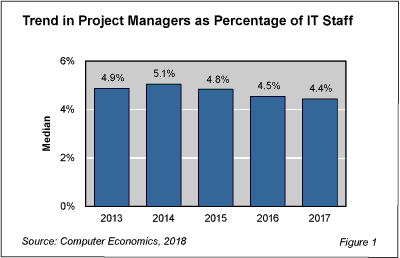In today’s environment of fast-paced change, the role of the IT project manager would appear to be critical. New technology adoption, regulatory compliance, outsourcing, and the ever-present mandate to do more with less make it vital that projects be properly planned and controlled. Even with the use of project managers, IT projects often fail to come in on time and on budget. The need seems clear, and yet, for the fourth straight year, the percentage of IT staff dedicated to project management has fallen.
As shown in Figure 1 from the full report, IT Project Management Staffing Ratios, project managers in 2017 made up 4.4% of the IT staff at the median, only slightly down from 4.5% in 2016. But the trend is clear. Project managers have been on decline from a recent high of 5.1% in 2014. This may have to do with reorganizing the way the IT department works and phasing out the dedicated project management role in some areas.

Although the project manager is not responsible for the direct creation of project deliverables such as systems design, program code, or documentation, he or she is responsible for ensuring that these deliverables are completed according to plan. However, many software development methods such as Agile and Scrum are moving away from a dedicated project management role that oversees the entire project and putting project management responsibilities on the developers themselves. Project management tools and best practices are also allowing for PMs to oversee more and larger projects. Between these two trends, fewer PMs are needed to do the same work.
“We’re seeing IT organizations increasingly emphasize so-called ‘soft skills’ when it comes to IT professionals,” said David Wagner vice president of research for Computer Economics based in Irvine, CA, “One of the skills they are emphasizing is the ability to work with the business to manage requirements, priorities, deadlines, and other areas traditionally performed by the project manager. It is becoming part of every IT professional’s job to be their own project manager. Because of this, we expect the decline to continue. However, there is value to having someone whose job is to see the big picture with larger projects, so the role will continue to be a part of most organizations.”
How much project management is the right amount? This can be a particularly vexing question for CIOs. The penalties for no project management, or very little, can be severe. A significant portion of capital investment can be placed at risk. Lack of effective project management is a primary cause of failed projects. On the other hand, there also can be a penalty for having too much project management. Each project manager places demands on participants for their limited time. Someone participating in multiple projects, or someone micro-managed in a particular project, introduces inefficiencies, and paradoxically can put important projects at risk.
In the full study, we examine the question of how many project managers a typical IT organization requires. We present five benchmarks: project managers as a percentage of the IT staff, project managers as a percentage of the Application Group, users per project manager, applications per project manager, and application programmers per project manager. All of these ratios are presented by organization size. In addition, we look at the influence of sector on the key ratios. We conclude with recommendations on assessing the performance of the project management function.
This Research Byte is a brief overview of our report on this subject, IT Project Management Staffing Ratios. The full report is available at no charge for Computer Economics clients, or it may be purchased by non-clients directly from our website (click for pricing).
Do you also need staffing ratios for other IT job functions? Consider this collection of all of our staffing ratio reports, which bundles them all into a single report at a significant discount: IT Staffing Ratios–Special Report Bundle.

